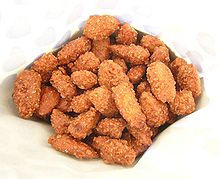 Candied almonds Candied almonds | |||||||
| Alternative names | Gebrannte Mandeln, Garrapiñadas, Addormentasuocere | ||||||
|---|---|---|---|---|---|---|---|
| Place of origin | France | ||||||
| Main ingredients | Almonds | ||||||
| Ingredients generally used | Sugar | ||||||
| Food energy (per 100 g serving) | 304 kcal (1273 kJ) | ||||||
| Nutritional value (per 100 g serving) |
| ||||||
Candied almonds or Praline are nuts (usually almonds) of French origin, that have been cooked in a special way, so they end up coated in browned, crunchy sugar. Candied almonds are cooked by heating brown sugar or white sugar, cinnamon and water in a pan then dipping the almonds in the sugar mixture.
History
The first recipe for candied almonds is said to have been invented in the 17th century by Clément Jaluzot, the head chef of Marshal du Plessis-Praslin (hence the name praline in French). This almonds can be crushed to make praliné, used in pastries, and the sugar is caramelised, giving it a brown colour.
The history of pralines is a bit mysterious, with different stories about their origin, but it is widely agreed that they are named after Marshal du Plessis, Duke of Choiseul-Praslin. There are also claims about the unofficial creator of the praline, with Chef Clement Lassagne being one of the alleged creators.
Other names
They are a typical open air fair snack in several countries where they receive different names. In France, praline is the common name but sometimes they are simply called amandes grillées. In Spain they are called garrapiñadas. In Austria, Switzerland and Germany they are called Gebrannte Mandeln. They are also fairly common in Denmark, Norway and Sweden, being frequently sold at Christmas markets, where they are similarly known as brændte mandler, brente mandler and brända mandlar, respectively.
See also
References
- Movida's Guide to Barcelona - Frank Camorra
- Coques i corassons i altres llepolies de la Ribera d'Ebre i la Terra Alta - Anna Llop i Rams, Laura Mur i Cervelló. p. 17. (in Spanish)
- "Candied Almonds". Allrecipes. Retrieved 2020-12-08.
- Perrier-Robert, Annie (2012-10-18). Dictionnaire de la gourmandise (in French). Groupe Robert Laffont. ISBN 978-2-221-13403-0.
- Pravaz (2016-01-26). Histoire de Praline (in French). HACHETTE LIVRE. ISBN 978-2-01-614621-7.
- "Burnt Sugar Almonds - Gebrannte Mandeln from Germany". About.com: German Foods. Archived from the original on 4 January 2017. Retrieved 12 August 2014.
| Nut and seed confections | |||||||||
|---|---|---|---|---|---|---|---|---|---|
| Whole or crushed |
| ||||||||
| Ground | |||||||||
| Puréed | |||||||||
| Filling, topping or base |
| ||||||||
This Spanish dessert-related article is a stub. You can help Misplaced Pages by expanding it. |
This German dessert–related article is a stub. You can help Misplaced Pages by expanding it. |